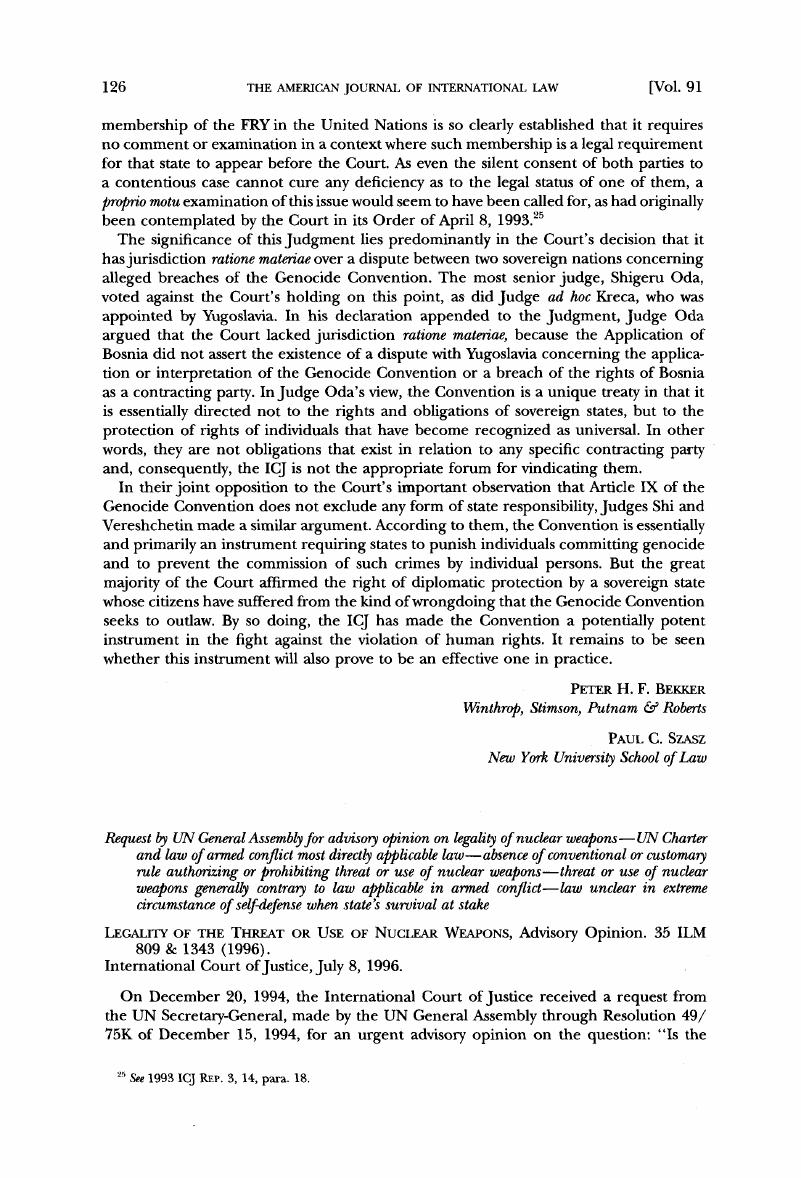Published online by Cambridge University Press: 27 February 2017

1 GA Res. 49/75K (Dec. 15, 1994), adopted by a vote of 78-43 (France, the Russian Federation, the United Kingdom and the United States voting against), with 38 abstentions. China was absent from the voting. For a summary of the background leading to Resolution 49/75K, see General List No. 95, Dissenting Opinion of Judge Oda, paras. 6–14. Written statements and comments were submitted to the ICJ by a number of states and public sittings were held between October 30 and November 15, 1995.
2 Advisory Opinion, para. 105 (operative paragraph) [hereinafter slip op.].
3 Id., paras. 11–12.
4 Id., para. 13.
5 According to Article 65(1) of the ICJ Statute: “The Court may give an advisory opinion on any legal question at the request of whatever body may be authorized by or in accordance with the Charter of the United Nations to make such a request” (emphasis added). See also Gerald Fitzmaurice, The Law and Procedure of the International Court of Justice 565–68 (1986) (calling this the Court’s “power of appreciation”).
6 Slip op., para. 16.
7 Id., paras. 34–36.
8 Id., paras. 39–44.
9 Id., paras. 47–48.
10 Id., para. 52 (emphasis added).
11 Id., paras. 54–57.
12 For a list of the treaties examined by the Court, see id., para. 58.
13 Id., para. 62 (emphasis added).
14 Id., para. 63.
15 Id., paras. 65–67.
16 Id., paras. 68–73.
17 Id., para. 78.
18 Id., para. 79. In contrast to what these words may seem to indicate, the Court elsewhere emphasized that it was not pronouncing itself on the question whether the principles and rules of humanitarian law are part of jus cogens. It did not do so because the General Assembly’s request did not raise the question of the legal character of the humanitarian law applicable to the use of nuclear weapons; rather, it raised the question of the applicability of that law in cases of recourse to nuclear weapons and the consequences of that applicability for the legality of recourse to those weapons. Id., para. 83.
19 Id., para. 86.
20 Id., para. 89.
21 Id., para. 95.
22 Id., paras. 95–97.
23 Id., para. 104.
24 July 1, 1968, 21 UST 483, 729 UNTS 161. Article VI reads: “Each of the Parties to the Treaty undertakes to pursue negotiations in good faith on effective measures relating to cessation of the nuclear arms race at an early date and to nuclear disarmament, and on a treaty on general and complete disarmament under strict and effective international control.”
25 Slip op., para. 99.
26 Id., para. 100. Judge Fleischhauer pointed out that paragraph 2F of the operative paragraph goes, stricdy speaking, beyond the question asked of the Court. According to Vice-President Schwebel, it is to be treated as dictum. Judge Oda argued that paragraph 2F should not have been advanced to the operative paragraph, as it simply reproduces Article VI of the Non-Proliferation Treaty.
27 This is the first time in the ICJ’s history that the President’s casting vote was used in advisory proceedings. President Sir Percy Spender used his casting vote in the Court’s Judgment of July 18, 1966, in South West Africa (Second Phase). See 1966 ICJ Rep. 6, 51.
28 See Fitzmaurice, supra note 5, at 567.
29 Slip op., para. 19. A further indication is found in paragraph 18 of the opinion, where the Court explained that its task was “to engage in its normal judicial function of ascertaining the existence or otherwise of legal principles and rules applicable to the threat or use of nuclear weapons” (emphasis added). The italicized words seem to indicate the reservation that the Court built in for itself in case it might find the absence of legal principles and rules.
30 Advisory Opinion, Dissenting Opinion of Judge Higgins, para. 7.
31 Advisory Opinion, Declaration of Judge Vereshchetin (emphasis added). But according to Vice-President Schwebel, the Court’s conclusion that it had no opinion on the basis that there is no law on the issue is an “astounding” and unnecessary one. At the heart of the different views expressed by the ICJ judges in their declarations and opinions lies a basic difference in view with regard to the Court’s judicial role as a court that states the law as it is or as one that also states the law as it should be. For expressions of the latter view, see especially the dissenting opinions of Judges Koroma and Weeramantry.
32 Advisory Opinion, Separate Opinion of Judge Shahabuddeen, part I, para. 6.
33 See slip op., para. 52, and text at note 10 supra.
34 According to the Court, “States must take environmental considerations into account when assessing what is necessary and proportionate in the pursuit of legitimate military objectives. Respect for the environment is one of the elements that go to assessing whether an action is in conformity with the principles of necessity and proportionality.” Slip op., para. 30.
35 Id., para. 41.
36 Cf. Bowett’s analysis with regard to earlier advisory cases. Derek Bowett, The Court’s role in relation to international organizations, in Fifty Years of the International Court of Justice 181, 185 (Vaughan Lowe & Malgosia Fitzmaurice eds., 1995). An encouraging initiative was taken on September 11, 1996, when the UN General Assembly adopted the so-called Comprehensive Test Ban Treaty.